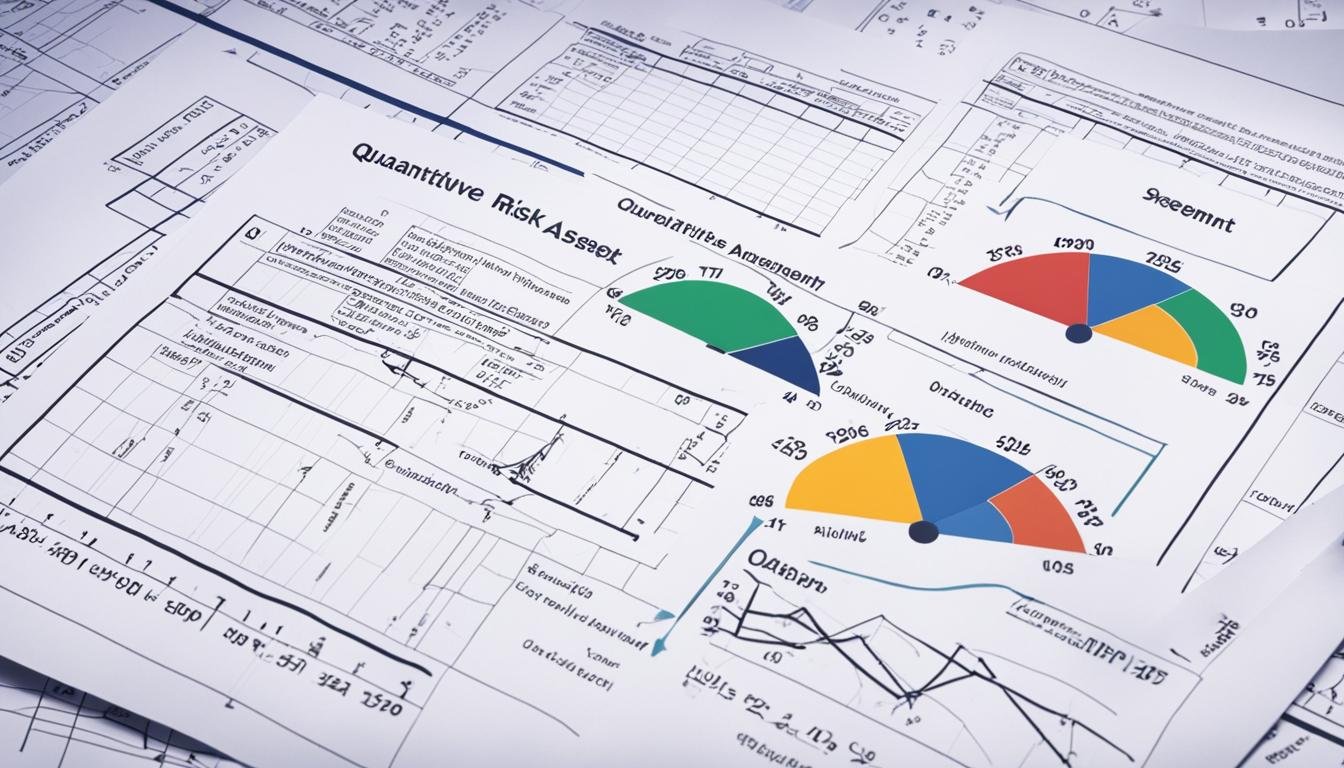Quantitative Risk Assessment Essentials
Quantitative risk assessment plays a critical role in identifying, analyzing, and mitigating potential risks across various industries. By utilizing advanced mathematical modeling and data analysis techniques, this systematic process quantifies the level of risk associated with specific hazards or events. In this article, we will explore the essentials of quantitative risk assessment, including its different methods, tools, and applications.
Key Takeaways:
- Quantitative risk assessment is a systematic process used to identify, analyze, and mitigate potential risks.
- It involves advanced mathematical modeling and data analysis techniques to quantify the level of risk associated with specific hazards or events.
- Quantitative risk assessment provides an objective and measurable approach to risk evaluation and prioritization.
- It is applicable across various industries, including engineering, project management, finance, insurance, and environmental sciences.
- Effective risk communication is essential in ensuring stakeholders’ understanding of risks and facilitating informed decision-making.
Understanding Risk Assessment
Risk assessment is a critical process that involves identifying and analyzing potential hazards and their associated risks. By evaluating the likelihood and impact of specific events or scenarios, organizations can effectively manage and mitigate risks to protect their interests.
There are several methods of risk assessment that provide valuable insights into the potential risks faced by businesses. One approach is quantitative risk assessment, which utilizes mathematical models and data analysis techniques to quantify risk levels. Through this method, organizations can assign numerical values to risks, enabling more objective risk evaluation and prioritization.
However, quantitative risk assessment is not the only method available. Other risk assessment techniques include:
- Qualitative assessments: These involve subjective evaluations of risk severity and probability, relying on expert judgment and experience to assess risks qualitatively.
- Semi-quantitative assessments: These combine elements of both qualitative and quantitative assessments, allowing for a more comprehensive understanding of risks by assigning numerical values to some aspects while relying on qualitative evaluation for others.
Each risk assessment method has its strengths and limitations, and the choice of approach depends on factors such as the nature of the risk, available data, and organizational preferences. Integrating various risk analysis techniques allows organizations to gain a holistic view of risks and make informed decisions accordingly.
Quantitative Methods for Analyzing Risk
Quantitative risk assessment utilizes numerical data and statistical analysis to objectively analyze and quantify risk levels. This approach provides a measurable framework for assessing and expressing the level of risk associated with specific hazards or events. By employing quantitative methods, organizations can gain a deeper understanding of the nature and potential impacts of risks, allowing for informed risk management strategies and decision-making processes.
Key components of quantitative risk assessment include:
- Probability Calculation: Quantifying the likelihood of specific risks occurring based on available data.
- Modeling: Constructing mathematical models to simulate risk scenarios and analyze their potential outcomes.
- Event Trees: Visual representations of potential risk events and their subsequent consequences.
- Multi-Criteria Decision Analysis: Assessing risks based on multiple factors and criteria to support prioritization and decision-making.
- Monte Carlo Analyses: Utilizing random sampling to simulate and evaluate different risk scenarios.
- Scenario Analysis: Identifying and analyzing various hypothetical risk scenarios to assess their impacts.
- Sensitivity Analysis: Assessing how changes in input variables affect the outcomes and impacts of risk events.
“Quantitative risk assessment allows organizations to quantify the potential impacts of risks, aiding in risk management strategies and decision-making processes.”
By implementing these quantitative methods, organizations can gain insights into the likelihood and severity of risks, enabling them to develop effective risk management strategies and allocate resources accordingly.
Now, let’s take a closer look at how these quantitative methods are used in practice. Below is a table showcasing a hypothetical scenario where quantitative risk assessment is applied to assess different risks:
| Risk Event | Likelihood | Severity | Risk Level |
|---|---|---|---|
| Natural Disaster | Low | High | Medium |
| Data Breach | High | Medium | High |
| Supply Chain Disruption | Medium | Medium | Medium |
| Regulatory Changes | Medium | Low | Low |
This table demonstrates how the combination of probability calculation, modeling, and severity assessment can help determine the risk level associated with different events. Based on this assessment, organizations can prioritize risks and implement appropriate risk management strategies based on their potential impacts and likelihood of occurrence.
Quantitative risk assessment provides organizations with valuable insights into potential risks, enabling them to make informed decisions and develop effective risk management strategies. In the next section, we will explore the importance of mathematical risk modeling in quantitative risk assessment.
Models and Their Importance in Risk Assessment
Models play a crucial role in quantitative risk assessment. They provide a structured and systematic approach to understanding and quantifying risks in various industries. By representing and simulating the behavior of elements and processes involved in a specific risk scenario, models enable organizations to analyze and evaluate the potential outcomes and consequences of specific risk events.
Mathematical risk modeling is a key component of quantitative risk assessment. It involves the use of advanced mathematical techniques and data analysis to create models that accurately depict the complex nature of risks. These models can range from simple to complex, depending on the complexity of the risk being assessed.
One example of a model-building process used in risk assessment is an event tree analysis. This method uses a graphical representation to visualize and analyze different possible outcomes and pathways of a specific event. By mapping out the sequence of events and their associated probabilities, organizations can identify the most significant factors contributing to risk and develop effective mitigation strategies.
Another commonly used modeling technique is Monte Carlo analysis. This method involves running multiple simulations to estimate the possible range of outcomes and associated probabilities. By incorporating uncertainties and variability into the model, organizations can gain a more comprehensive understanding of the potential impacts and uncertainties associated with specific risk events.
Overall, models provide organizations with a systematic framework for risk assessment. They allow for a more objective and quantifiable approach to understanding and managing risks, enabling organizations to make informed decisions and allocate resources effectively.
Example of Risk Event Tree Analysis:
| Event | Probability | Consequences |
|---|---|---|
| 1. Equipment failure | 0.15 | Minor disruption to operations |
| 2. Natural disaster | 0.05 | Significant damage and downtime |
| 3. Cybersecurity breach | 0.10 | Data breach and financial loss |
In the example event tree analysis above, three potential risk events have been identified along with their associated probabilities and consequences. This analysis allows organizations to prioritize efforts and resources on the most significant risks to minimize potential impacts.
The Importance of Risk Communication
Risk communication is a fundamental aspect of risk assessment that plays a crucial role in promoting transparency, understanding, and effective risk management strategies. It involves the exchange of information among stakeholders to ensure that decision-makers, employees, and other relevant parties are aware of the potential risks and can make informed decisions to mitigate them. Effective risk communication is a multidirectional process that fosters accountability and facilitates collaborative efforts in addressing risks.
Enhancing Understanding and Awareness
One of the key objectives of risk communication is to enhance understanding and awareness of risks among stakeholders. By effectively communicating the nature, severity, and potential impacts of risks, organizations can ensure that everyone involved has a comprehensive understanding of the risks they face. This shared understanding enables proactive risk management, reducing the likelihood of adverse events and minimizing their potential consequences.
“Effective risk communication can help stakeholders recognize the importance of implementing appropriate risk management measures and create a culture of safety and vigilance.” – John Smith, Risk Management Expert
Facilitating Risk Management Strategies
Risk communication also plays a crucial role in facilitating the development and implementation of effective risk management strategies. By providing clear and concise information about risks, stakeholders are empowered to make informed decisions and take appropriate actions to mitigate those risks. This ensures that risk management efforts are coordinated, efficient, and aligned with organizational objectives.
Promoting Transparency and Accountability
Transparency and accountability are vital components of effective risk management. Risk communication acts as a conduit for sharing information openly and honestly with stakeholders, fostering transparency in the decision-making process. By being transparent about risks and the steps taken to mitigate them, organizations can build trust and credibility among stakeholders, demonstrating a commitment to safety and responsible risk management practices.
The Role of Risk Communication in Crisis Situations
In crisis situations, risk communication becomes even more critical. Prompt and accurate communication is essential for managing crises effectively and minimizing the impact on people, the environment, and organizations. By providing timely updates, guidance, and instructions, risk communication helps individuals and organizations understand the unfolding situation, take necessary precautions, and make informed decisions.
The Benefits of Visual Communication
Visual communication is a powerful tool in risk communication. Visual aids such as charts, graphs, and infographics can help convey complex information in a clear and concise manner. Additionally, the use of visual imagery can evoke emotions, engage stakeholders, and enhance understanding. Implementing visual elements in risk communication materials can significantly improve the effectiveness of the message being conveyed.
Overall, risk communication is an integral part of the risk assessment process. By facilitating understanding, supporting risk management strategies, promoting transparency, and leveraging visual communication, organizations can effectively navigate the complexities of risk and ensure the safety and well-being of their stakeholders.
Benefits of Quantitative Risk Assessment
Quantitative risk assessment offers several benefits compared to other risk assessment methods. It provides a more objective and standardized approach to risk evaluation and quantification, allowing for better comparison and prioritization of risks. With the aid of quantitative analysis, organizations gain a deeper understanding of the potential impacts and consequences of risks, enabling informed decision-making and effective implementation of risk mitigation strategies.
One of the key advantages of quantitative risk assessment is its ability to provide a numerical representation of risk levels. By assigning numerical values to risks, organizations can measure and compare their severity, allowing for more accurate risk prioritization. This helps organizations allocate their resources more effectively by addressing risks with the highest potential impact first.
Enhanced Risk Evaluation and Quantification
Risk evaluation and quantification are crucial aspects of risk management. By using quantitative risk assessment, organizations can evaluate risks based on measurable data and objective analysis, reducing the subjectivity often associated with qualitative assessments. This provides a more robust and reliable foundation for decision-making.
- Quantitative risk assessment enables organizations to calculate the probability of specific risks occurring, helping them understand the likelihood of potential events and their potential impact on the business.
- Through detailed analysis, organizations can identify and quantify the potential financial, operational, reputational, and legal consequences of risks. This information allows for better planning, resource allocation, and risk mitigation strategies.
- The use of quantitative analysis techniques, such as statistical modeling and simulation, helps organizations model different risk scenarios and assess their potential outcomes. This allows for better risk assessment and enables organizations to make more informed decisions.
Deeper Understanding of Risks
Quantitative risk assessment provides organizations with a deeper understanding of various risks they face. By using mathematical models and data analysis techniques, organizations can gain insights into the complex relationships between different risk factors and their potential impacts, which may not be apparent with other assessment methods.
“Quantitative risk assessment enables organizations to go beyond surface-level assessments and uncover hidden risks and potential dependencies.”
For instance, by analyzing historical data and performing simulations, organizations can identify potential cascading effects of risks and understand how one risk event can lead to the occurrence of others. This helps organizations implement targeted risk mitigation strategies that consider multiple interconnected risks simultaneously.
Overall, the benefits of quantitative risk assessment include:
- A more objective and standardized approach to risk evaluation and prioritization.
- Enhanced understanding of risks and their potential impacts.
- Improved decision-making and resource allocation.
- Better identification and quantification of risks.
- More effective implementation of risk mitigation strategies.
With these benefits, organizations can gain a competitive edge by effectively managing and mitigating risks that could otherwise hinder their performance and success.
Applications of Quantitative Risk Assessment
Quantitative risk assessment is a versatile tool that finds extensive applications across various industries and sectors. It plays a crucial role in engineering, project management, finance, insurance, and environmental sciences, among others. Organizations rely on quantitative risk assessment to identify and mitigate risks associated with specific projects, operations, or policies, enabling them to make informed decisions and develop effective risk management strategies.
By utilizing quantitative risk assessment, organizations can minimize potential adverse effects and optimize resource allocation. The data-driven approach of quantitative risk assessment provides valuable insights into the potential risks involved, allowing organizations to prioritize risk mitigation efforts and allocate resources accordingly. This helps in minimizing the impact of uncertain events and safeguarding the organization’s interests.
“Quantitative risk assessment is a fundamental component of risk management strategies in various industries. It helps organizations understand the potential risks they face and develop effective strategies to mitigate those risks.”
Real-World Examples of Quantitative Risk Assessment Applications
Let’s explore some specific examples of how quantitative risk assessment is applied in different industries:
| Industry | Application |
|---|---|
| Engineering | Quantifying the risk of structural failures in buildings and infrastructure projects to ensure safety |
| Project Management | Evaluating the potential risks and uncertainties associated with project timelines, budgets, and resource allocation |
| Finance | Assessing market risks and optimizing investment portfolios to maximize returns |
| Insurance | Determining insurance premiums by evaluating the likelihood and severity of potential risks |
| Environmental Sciences | Analyzing the potential consequences of environmental hazards and guiding policies and regulations |
These examples highlight a few of the many applications of quantitative risk assessment, emphasizing the importance of this approach in various industries. By employing quantitative risk assessment techniques, organizations can proactively identify and mitigate risks to safeguard their operations and assets.
Integration of Quantitative Risk Assessment with Other Approaches
Quantitative risk assessment can be integrated with other risk assessment approaches to provide a more comprehensive understanding of risks. By combining different methods, organizations can enhance their risk management strategies and make more informed decisions. Here are two common approaches where quantitative risk assessment can be integrated:
1. Complementing Qualitative Risk Assessments
Quantitative risk assessment can complement qualitative risk assessments by providing numerical data and measurements to support risk rankings or descriptions. While qualitative assessments rely on subjective evaluations, quantitative analysis brings objectivity and precision to risk evaluation. By quantifying risks, organizations can better prioritize their mitigation efforts and allocate resources effectively.
2. Combining with Asset or Vulnerability-based Risk Assessments
Quantitative risk assessment can also be combined with asset-based or vulnerability-based risk assessments. This integration helps identify and prioritize risks based on their potential impacts on specific assets or vulnerabilities. By considering the potential consequences of risks on critical assets or vulnerabilities, organizations can allocate resources more effectively and implement targeted risk mitigation strategies.
Integrating quantitative risk assessment with other approaches enhances the effectiveness of risk management strategies by providing a more holistic understanding of risks. By combining the strengths of different assessment methods, organizations can improve their risk evaluation and make more informed decisions.
| Approach | Advantages |
|---|---|
| Complementing Qualitative Risk Assessments |
|
| Combining with Asset or Vulnerability-based Risk Assessments |
|
Limitations and Considerations of Quantitative Risk Assessment
While quantitative risk assessment offers significant advantages, it is important to acknowledge its limitations and considerations. Understanding these constraints is vital for organizations to effectively utilize this approach to risk management.
Data Availability and Quality:
Quantitative risk assessment heavily relies on the availability and quality of data. Accurate and reliable data is essential for accurate risk analysis and modeling. Organizations must invest time and resources into collecting and validating data to ensure the integrity of their risk assessments.
Complex Models and Expertise:
Performing quantitative risk assessment requires specialized knowledge and expertise, particularly when dealing with complex models. Organizations without access to the necessary resources or expertise may find it challenging to implement and interpret the results of quantitative risk assessments effectively.
“Quantitative risk assessment often involves intricate mathematical modeling and statistical analysis. It is crucial for organizations to have expert staff or consult professionals to navigate these complexities.” – Dr. Risk Expert
Uncertainties and Assumptions:
Quantitative risk assessment involves inherent uncertainties and assumptions. The models used to analyze risks are based on various assumptions and simplifications, which can affect the accuracy of the results. Organizations must carefully consider and communicate these uncertainties and assumptions to stakeholders to ensure a comprehensive understanding of the risks involved.
Limitations Table:
| Limitations | Considerations |
|---|---|
| Data Availability and Quality | Validate and verify data to ensure accuracy and reliability. |
| Complex Models and Expertise | Seek specialized knowledge and expertise for accurate analysis and interpretation. |
| Uncertainties and Assumptions | Communicate uncertainties and assumptions to stakeholders for a comprehensive risk understanding. |
Despite these limitations, quantitative risk assessment remains a valuable tool for organizations to identify and manage potential risks. By acknowledging and addressing these considerations, organizations can enhance the accuracy and reliability of their risk assessments, enabling them to make informed decisions and develop effective risk mitigation strategies.
Best Practices for Conducting Quantitative Risk Assessment
Conducting quantitative risk assessments requires adherence to best practices to ensure effectiveness and reliability. By following these practices, organizations can obtain accurate and actionable insights from their risk assessments. Here are some key best practices to consider:
- Use appropriate and validated models: Selecting the right models for quantitative risk assessment is crucial. Organizations should use models that accurately represent the specific risk scenarios they are assessing. It is also important to ensure that these models are validated and have been verified to produce reliable results.
- Collect reliable and relevant data: The quality of data used in quantitative risk assessment greatly impacts the accuracy of the results. Organizations should gather data from reliable sources and ensure its relevance to the identified risks. Validating and verifying the collected data is also important to minimize errors and biases in the assessment.
- Involve relevant stakeholders: Stakeholder involvement is essential for a comprehensive quantitative risk assessment. Including subject matter experts, managers, and other stakeholders ensures that different perspectives and knowledge are considered in the assessment process. This promotes a more holistic understanding of risks and facilitates better decision-making.
- Conduct sensitivity analyses: Sensitivity analyses help assess the impact of uncertainties on the results of a quantitative risk assessment. By varying input parameters and assumptions, organizations can understand how changes in these factors affect the overall risk assessment. This analysis improves the robustness of the assessment and enables organizations to identify critical risk drivers.
- Regularly review and update the assessment: Risk profiles change over time due to various factors such as market conditions, technology advancements, and regulatory changes. Organizations should regularly review and update their quantitative risk assessments to reflect these changes. This ensures that risk mitigation strategies and decision-making processes remain relevant and effective.
By following these best practices, organizations can enhance the accuracy, reliability, and usability of their quantitative risk assessments. These practices enable organizations to make informed decisions, prioritize risks effectively, and optimize their risk management strategies.
Resources for Quantitative Risk Assessment
When it comes to conducting quantitative risk assessments, organizations have access to a variety of valuable resources. These resources serve as valuable tools, providing the necessary knowledge, guidance, and support for effective risk assessment and management practices.
Software Tools
Specialized software tools designed specifically for quantitative risk assessment are available and can significantly streamline the assessment process. These tools offer advanced modeling capabilities, data analysis features, and visualization options to enhance risk evaluation and decision-making. Some popular software options include:
- XYZ Risk Analyzer
- ABC Risk Manager
- 123 Risk Assessment Suite
These software tools enable organizations to perform complex calculations, simulate risk scenarios, and generate comprehensive reports for informed risk management.
Guidelines and Standards
Industry organizations and regulatory bodies often provide guidelines and standards that organizations can follow to conduct quantitative risk assessments effectively. These guidelines offer best practices, methodologies, and frameworks for conducting assessments in specific industries or sectors. Adhering to these guidelines ensures that organizations use standardized approaches and achieve consistent and reliable results.
“Following industry guidelines and standards is crucial for maintaining consistency and reliability in quantitative risk assessment. It helps organizations align their practices with recognized industry standards and ensures a robust evaluation of potential risks.”
Research Papers and Publications
Research papers and publications contribute to the collective knowledge and advancements in the field of quantitative risk assessment. These resources provide in-depth analyses, case studies, and insights into the latest methodologies and tools for risk assessment. Organizations can leverage these resources to stay updated with the latest developments and incorporate cutting-edge practices into their risk management strategies.
Training Courses and Modules
Training courses and modules on quantitative risk assessment are available to help organizations build internal capabilities and expertise in conducting assessments. These courses cover various aspects of risk assessment, including data collection, modeling techniques, analysis methodologies, and interpretation of results. By investing in training, organizations can equip their teams with the necessary skills and knowledge to perform accurate and comprehensive risk assessments.
By utilizing the resources mentioned above, organizations can enhance their quantitative risk assessments and strengthen their overall risk management practices. These resources provide valuable support at each stage of the assessment process, from data collection and analysis to interpretation and decision-making.
Next, we will explore the importance of risk communication and its role in effective risk management.
Conclusion
Quantitative risk assessment is a powerful tool that enables organizations to effectively identify, analyze, and mitigate potential risks. By utilizing advanced mathematical modeling and data analysis techniques, organizations gain an objective and measurable approach to evaluating and prioritizing risks. This allows for informed decision-making and the implementation of effective risk management strategies.
Integrating quantitative risk assessment with other approaches enhances the comprehensiveness and accuracy of risk evaluations. By combining quantitative and qualitative assessments, organizations can leverage both numerical data and subjective evaluations to gain a holistic understanding of risks. Additionally, integrating quantitative risk assessment with asset-based or vulnerability-based assessments helps identify and prioritize risks based on their potential impacts on specific assets or vulnerabilities.
However, it is important to consider the limitations and best practices associated with quantitative risk assessment. The availability and quality of data, as well as the complexity of models, can impact the accuracy of risk evaluations. Organizations must ensure reliable data collection, validation, and use appropriate and validated models. Regularly reviewing and updating risk assessments to reflect changes in risk profiles is also crucial for maintaining accurate and actionable insights.
With the resources available, organizations can enhance their risk management practices and optimize their overall risk posture. Software tools designed for quantitative risk assessment, industry guidelines and standards, research papers, and training courses provide valuable support and guidance. By leveraging these resources and following best practices, organizations can effectively manage risks, make informed decisions, and prioritize their resources to minimize potential risks and maximize their chances of success.







